Assessment 2: Short Answer Essays on Behaviour and Mind
VerifiedAdded on 2022/12/28
|8
|1975
|94
Homework Assignment
AI Summary
This document presents a student's homework assignment on Behaviour and Mind, comprising short answer essays addressing various psychological concepts. The assignment delves into the differences between positive and negative reinforcement, explaining their roles in shaping behavior. It then explores neuronal communication, detailing the electrochemical processes within neurons and the function of synapses. The assignment further examines depth perception, differentiating between monocular and binocular cues. Additionally, it discusses eyewitness memory, outlining factors that can influence its accuracy, such as anxiety, stress, and memory reconstruction. The concept of context-dependent memory is also explored, highlighting its role in memory retrieval. Finally, the assignment addresses negative transfer, explaining how prior experiences can impact new learning. Each essay is supported by relevant references, providing a comprehensive overview of the topics discussed.
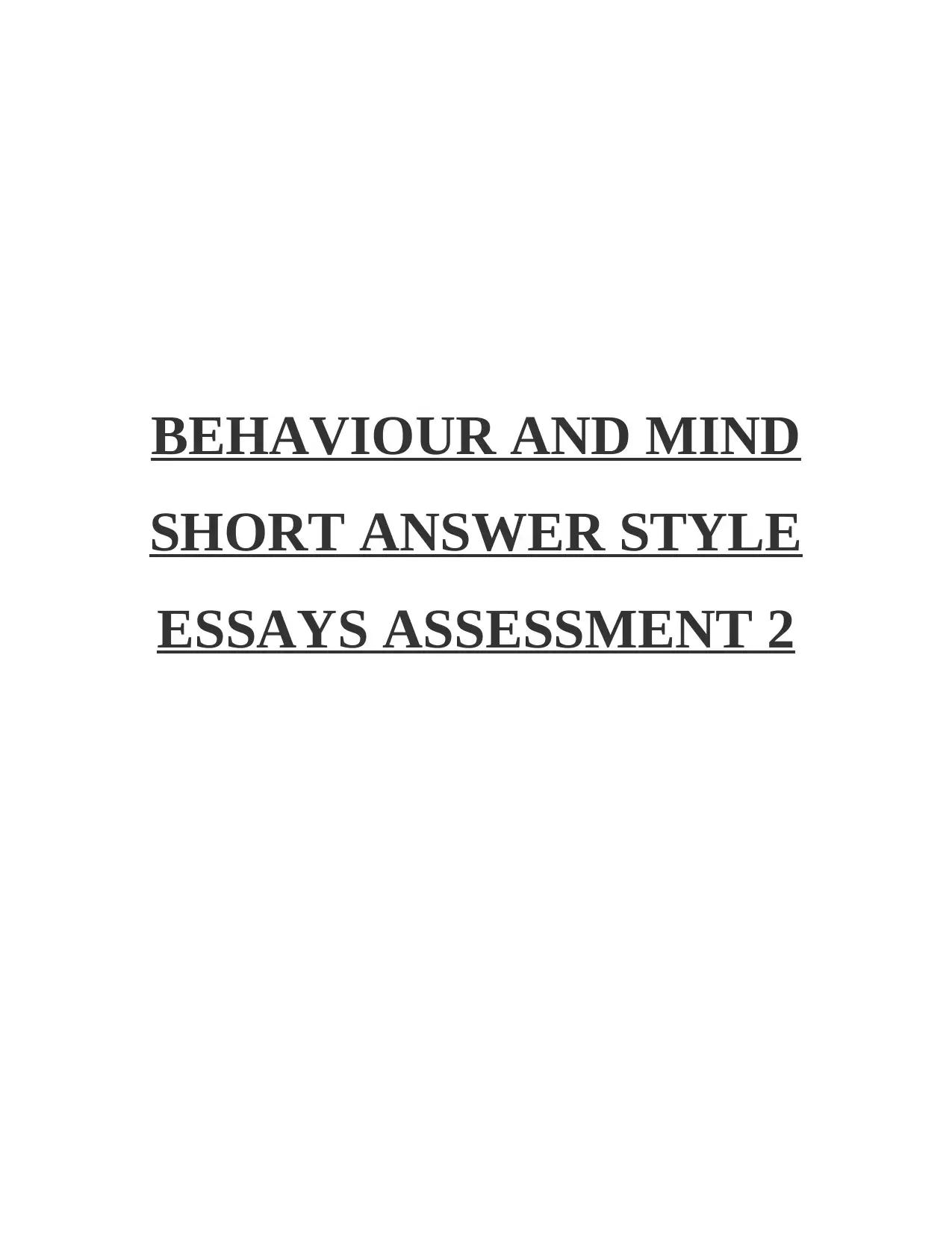
BEHAVIOUR AND MIND
SHORT ANSWER STYLE
ESSAYS ASSESSMENT 2
SHORT ANSWER STYLE
ESSAYS ASSESSMENT 2
Paraphrase This Document
Need a fresh take? Get an instant paraphrase of this document with our AI Paraphraser
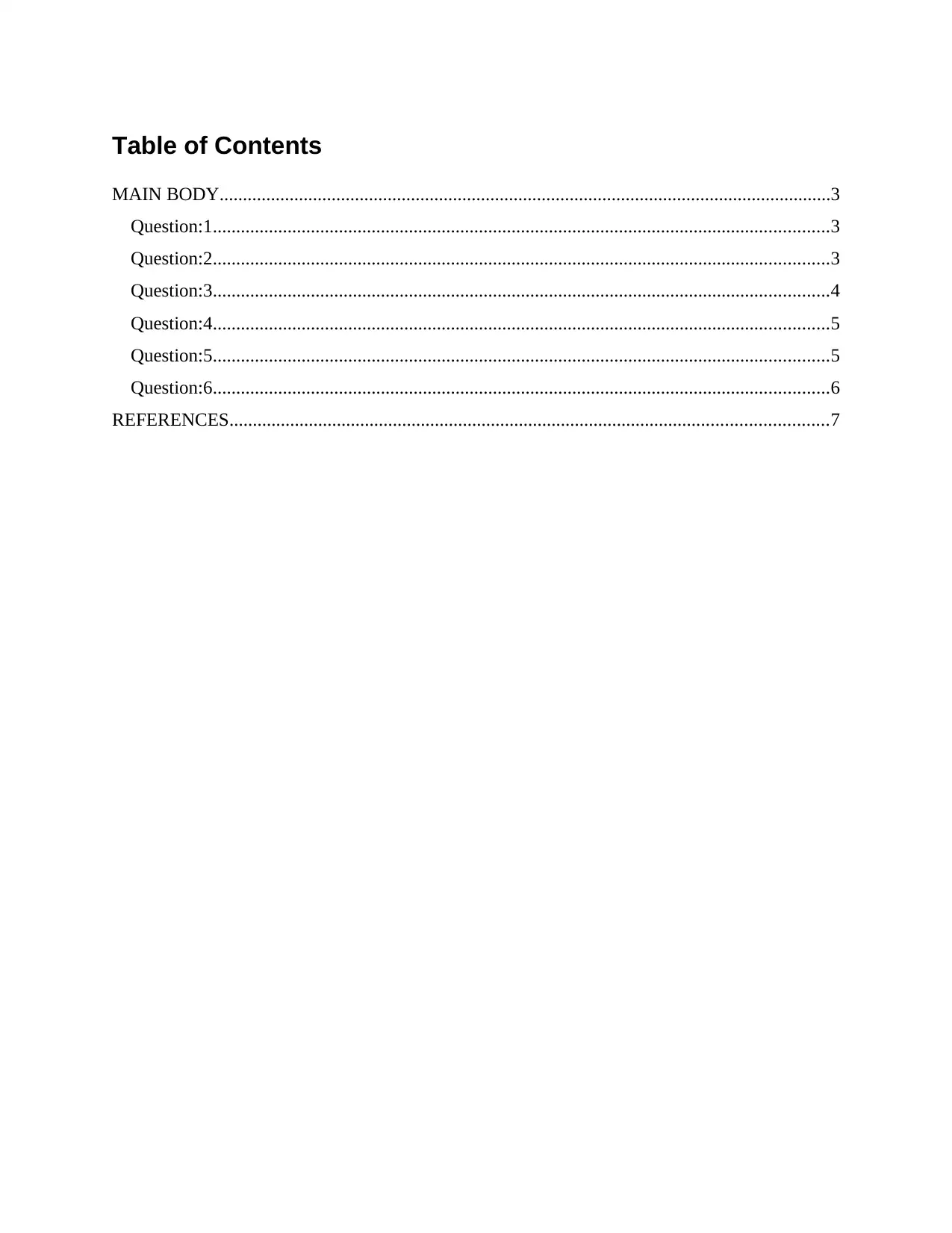
Table of Contents
MAIN BODY...................................................................................................................................3
Question:1....................................................................................................................................3
Question:2....................................................................................................................................3
Question:3....................................................................................................................................4
Question:4....................................................................................................................................5
Question:5....................................................................................................................................5
Question:6....................................................................................................................................6
REFERENCES................................................................................................................................7
MAIN BODY...................................................................................................................................3
Question:1....................................................................................................................................3
Question:2....................................................................................................................................3
Question:3....................................................................................................................................4
Question:4....................................................................................................................................5
Question:5....................................................................................................................................5
Question:6....................................................................................................................................6
REFERENCES................................................................................................................................7
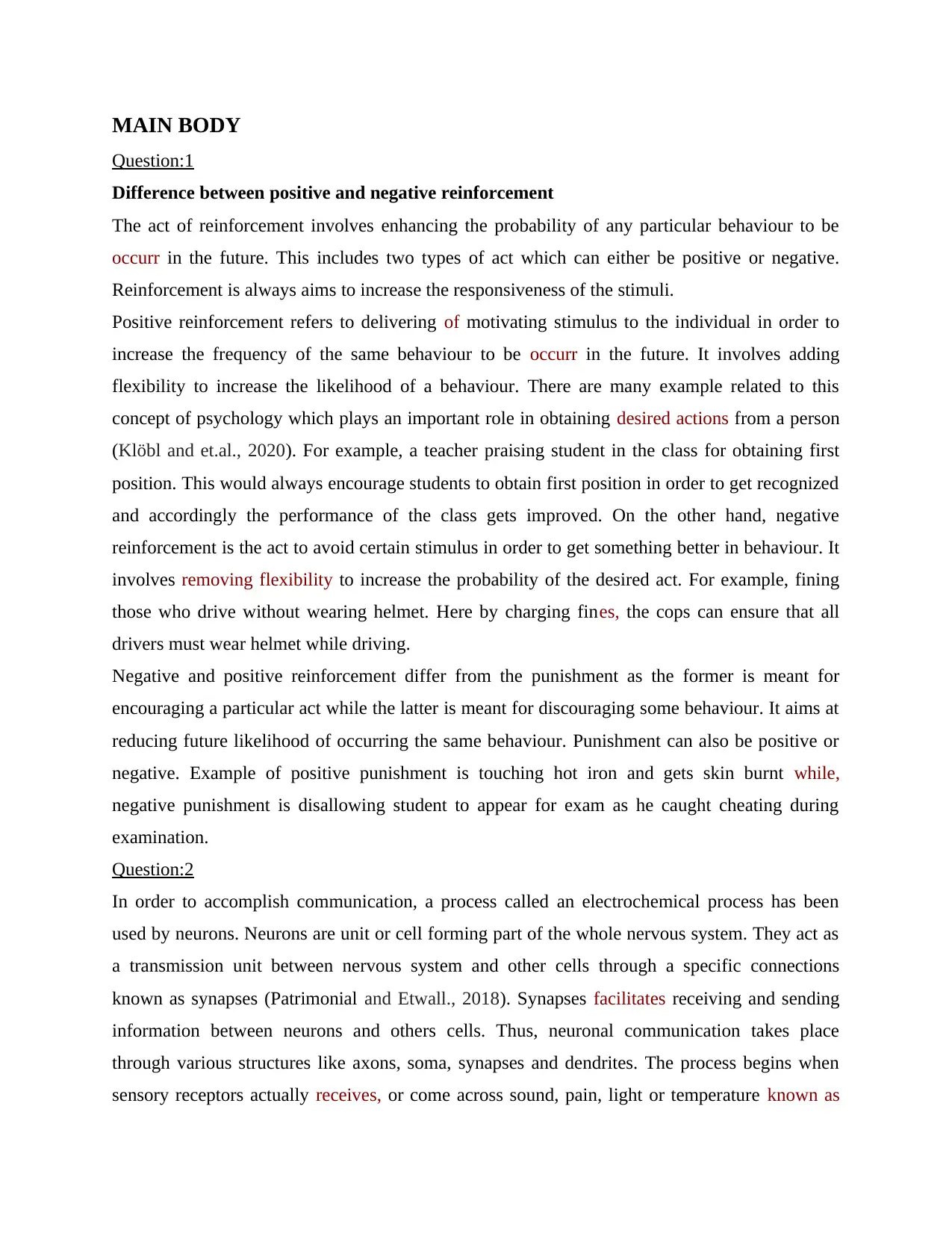
MAIN BODY
Question:1
Difference between positive and negative reinforcement
The act of reinforcement involves enhancing the probability of any particular behaviour to be
occurr in the future. This includes two types of act which can either be positive or negative.
Reinforcement is always aims to increase the responsiveness of the stimuli.
Positive reinforcement refers to delivering of motivating stimulus to the individual in order to
increase the frequency of the same behaviour to be occurr in the future. It involves adding
flexibility to increase the likelihood of a behaviour. There are many example related to this
concept of psychology which plays an important role in obtaining desired actions from a person
(Klöbl and et.al., 2020). For example, a teacher praising student in the class for obtaining first
position. This would always encourage students to obtain first position in order to get recognized
and accordingly the performance of the class gets improved. On the other hand, negative
reinforcement is the act to avoid certain stimulus in order to get something better in behaviour. It
involves removing flexibility to increase the probability of the desired act. For example, fining
those who drive without wearing helmet. Here by charging fines, the cops can ensure that all
drivers must wear helmet while driving.
Negative and positive reinforcement differ from the punishment as the former is meant for
encouraging a particular act while the latter is meant for discouraging some behaviour. It aims at
reducing future likelihood of occurring the same behaviour. Punishment can also be positive or
negative. Example of positive punishment is touching hot iron and gets skin burnt while,
negative punishment is disallowing student to appear for exam as he caught cheating during
examination.
Question:2
In order to accomplish communication, a process called an electrochemical process has been
used by neurons. Neurons are unit or cell forming part of the whole nervous system. They act as
a transmission unit between nervous system and other cells through a specific connections
known as synapses (Patrimonial and Etwall., 2018). Synapses facilitates receiving and sending
information between neurons and others cells. Thus, neuronal communication takes place
through various structures like axons, soma, synapses and dendrites. The process begins when
sensory receptors actually receives, or come across sound, pain, light or temperature known as
Question:1
Difference between positive and negative reinforcement
The act of reinforcement involves enhancing the probability of any particular behaviour to be
occurr in the future. This includes two types of act which can either be positive or negative.
Reinforcement is always aims to increase the responsiveness of the stimuli.
Positive reinforcement refers to delivering of motivating stimulus to the individual in order to
increase the frequency of the same behaviour to be occurr in the future. It involves adding
flexibility to increase the likelihood of a behaviour. There are many example related to this
concept of psychology which plays an important role in obtaining desired actions from a person
(Klöbl and et.al., 2020). For example, a teacher praising student in the class for obtaining first
position. This would always encourage students to obtain first position in order to get recognized
and accordingly the performance of the class gets improved. On the other hand, negative
reinforcement is the act to avoid certain stimulus in order to get something better in behaviour. It
involves removing flexibility to increase the probability of the desired act. For example, fining
those who drive without wearing helmet. Here by charging fines, the cops can ensure that all
drivers must wear helmet while driving.
Negative and positive reinforcement differ from the punishment as the former is meant for
encouraging a particular act while the latter is meant for discouraging some behaviour. It aims at
reducing future likelihood of occurring the same behaviour. Punishment can also be positive or
negative. Example of positive punishment is touching hot iron and gets skin burnt while,
negative punishment is disallowing student to appear for exam as he caught cheating during
examination.
Question:2
In order to accomplish communication, a process called an electrochemical process has been
used by neurons. Neurons are unit or cell forming part of the whole nervous system. They act as
a transmission unit between nervous system and other cells through a specific connections
known as synapses (Patrimonial and Etwall., 2018). Synapses facilitates receiving and sending
information between neurons and others cells. Thus, neuronal communication takes place
through various structures like axons, soma, synapses and dendrites. The process begins when
sensory receptors actually receives, or come across sound, pain, light or temperature known as
⊘ This is a preview!⊘
Do you want full access?
Subscribe today to unlock all pages.

Trusted by 1+ million students worldwide
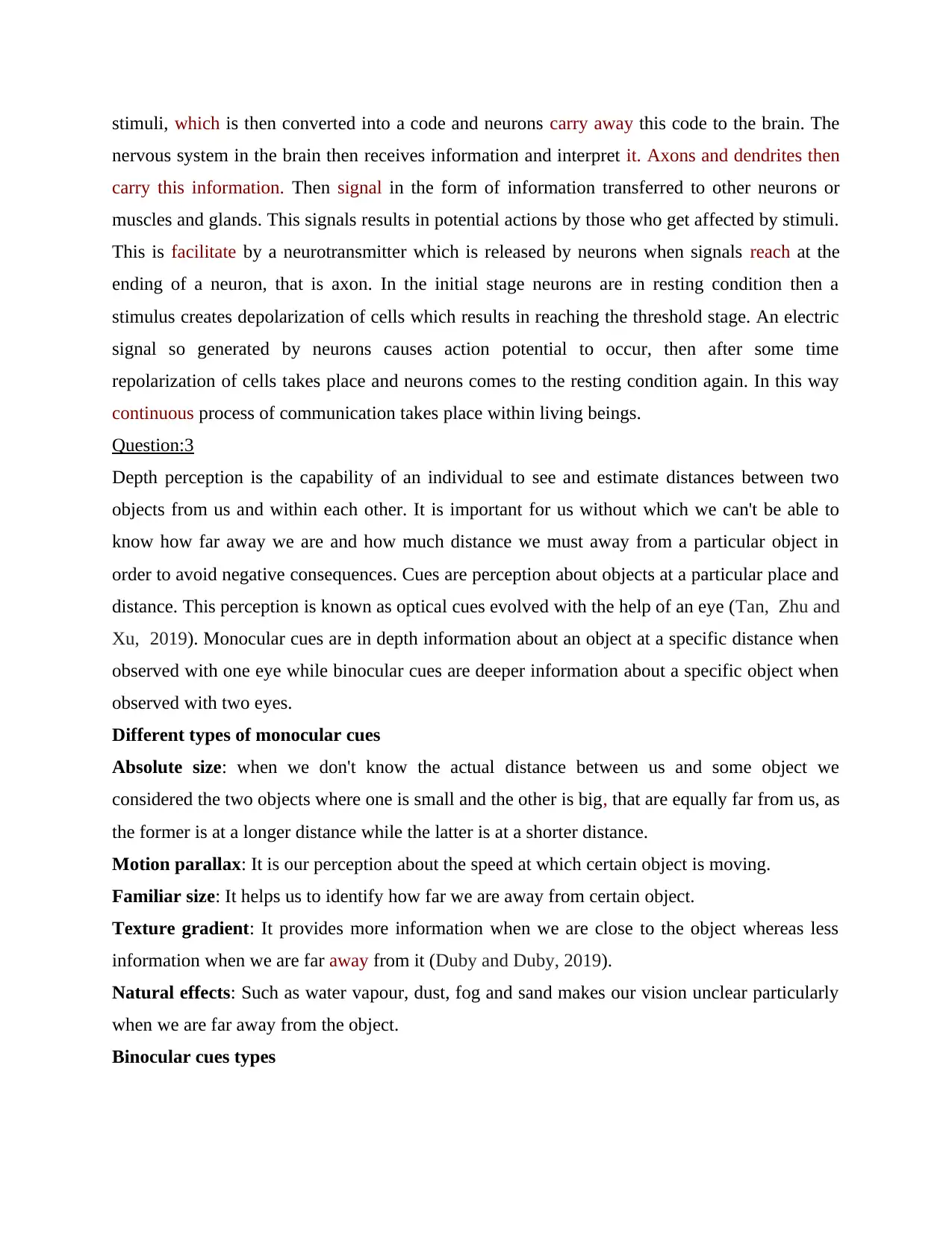
stimuli, which is then converted into a code and neurons carry away this code to the brain. The
nervous system in the brain then receives information and interpret it. Axons and dendrites then
carry this information. Then signal in the form of information transferred to other neurons or
muscles and glands. This signals results in potential actions by those who get affected by stimuli.
This is facilitate by a neurotransmitter which is released by neurons when signals reach at the
ending of a neuron, that is axon. In the initial stage neurons are in resting condition then a
stimulus creates depolarization of cells which results in reaching the threshold stage. An electric
signal so generated by neurons causes action potential to occur, then after some time
repolarization of cells takes place and neurons comes to the resting condition again. In this way
continuous process of communication takes place within living beings.
Question:3
Depth perception is the capability of an individual to see and estimate distances between two
objects from us and within each other. It is important for us without which we can't be able to
know how far away we are and how much distance we must away from a particular object in
order to avoid negative consequences. Cues are perception about objects at a particular place and
distance. This perception is known as optical cues evolved with the help of an eye (Tan, Zhu and
Xu, 2019). Monocular cues are in depth information about an object at a specific distance when
observed with one eye while binocular cues are deeper information about a specific object when
observed with two eyes.
Different types of monocular cues
Absolute size: when we don't know the actual distance between us and some object we
considered the two objects where one is small and the other is big, that are equally far from us, as
the former is at a longer distance while the latter is at a shorter distance.
Motion parallax: It is our perception about the speed at which certain object is moving.
Familiar size: It helps us to identify how far we are away from certain object.
Texture gradient: It provides more information when we are close to the object whereas less
information when we are far away from it (Duby and Duby, 2019).
Natural effects: Such as water vapour, dust, fog and sand makes our vision unclear particularly
when we are far away from the object.
Binocular cues types
nervous system in the brain then receives information and interpret it. Axons and dendrites then
carry this information. Then signal in the form of information transferred to other neurons or
muscles and glands. This signals results in potential actions by those who get affected by stimuli.
This is facilitate by a neurotransmitter which is released by neurons when signals reach at the
ending of a neuron, that is axon. In the initial stage neurons are in resting condition then a
stimulus creates depolarization of cells which results in reaching the threshold stage. An electric
signal so generated by neurons causes action potential to occur, then after some time
repolarization of cells takes place and neurons comes to the resting condition again. In this way
continuous process of communication takes place within living beings.
Question:3
Depth perception is the capability of an individual to see and estimate distances between two
objects from us and within each other. It is important for us without which we can't be able to
know how far away we are and how much distance we must away from a particular object in
order to avoid negative consequences. Cues are perception about objects at a particular place and
distance. This perception is known as optical cues evolved with the help of an eye (Tan, Zhu and
Xu, 2019). Monocular cues are in depth information about an object at a specific distance when
observed with one eye while binocular cues are deeper information about a specific object when
observed with two eyes.
Different types of monocular cues
Absolute size: when we don't know the actual distance between us and some object we
considered the two objects where one is small and the other is big, that are equally far from us, as
the former is at a longer distance while the latter is at a shorter distance.
Motion parallax: It is our perception about the speed at which certain object is moving.
Familiar size: It helps us to identify how far we are away from certain object.
Texture gradient: It provides more information when we are close to the object whereas less
information when we are far away from it (Duby and Duby, 2019).
Natural effects: Such as water vapour, dust, fog and sand makes our vision unclear particularly
when we are far away from the object.
Binocular cues types
Paraphrase This Document
Need a fresh take? Get an instant paraphrase of this document with our AI Paraphraser
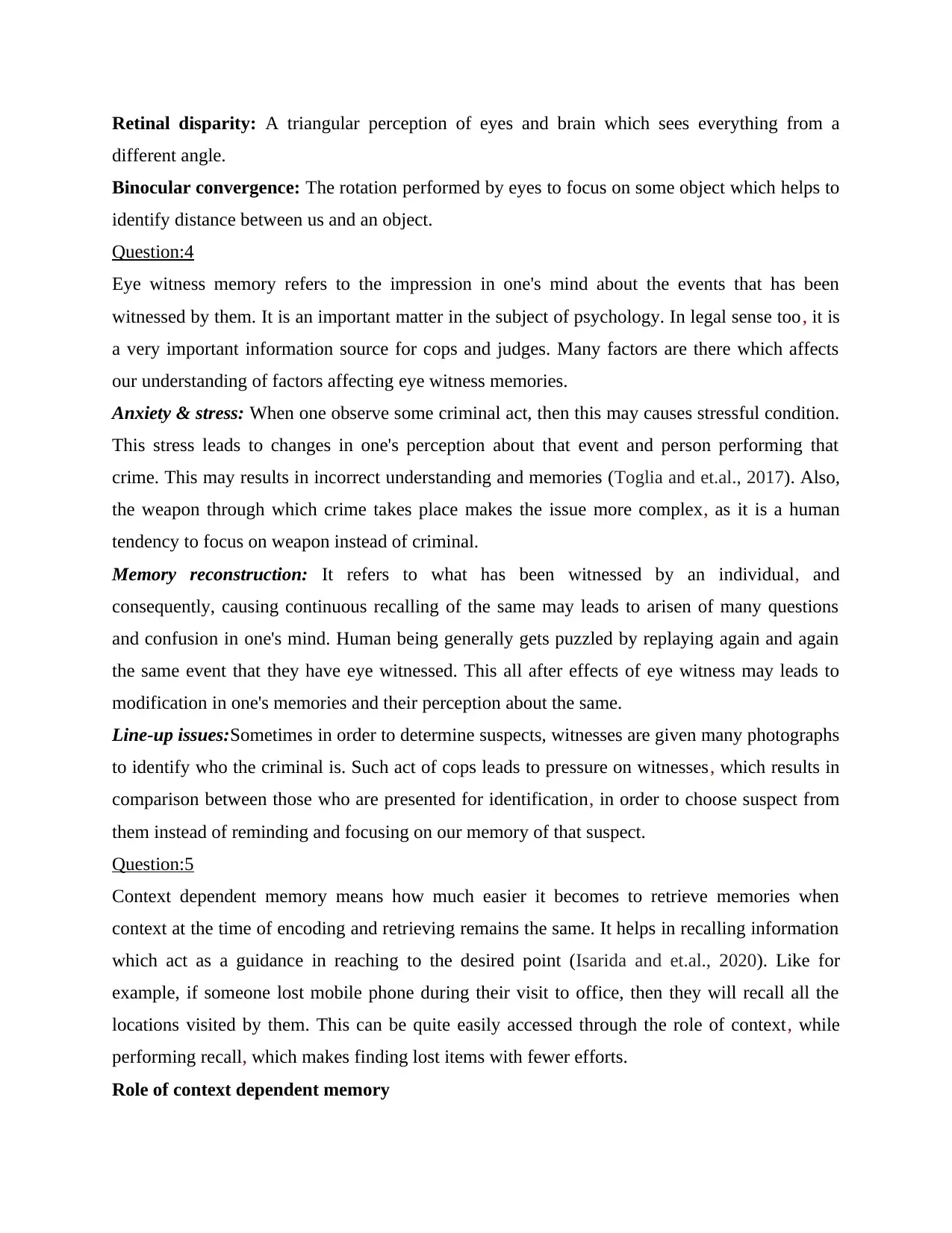
Retinal disparity: A triangular perception of eyes and brain which sees everything from a
different angle.
Binocular convergence: The rotation performed by eyes to focus on some object which helps to
identify distance between us and an object.
Question:4
Eye witness memory refers to the impression in one's mind about the events that has been
witnessed by them. It is an important matter in the subject of psychology. In legal sense too, it is
a very important information source for cops and judges. Many factors are there which affects
our understanding of factors affecting eye witness memories.
Anxiety & stress: When one observe some criminal act, then this may causes stressful condition.
This stress leads to changes in one's perception about that event and person performing that
crime. This may results in incorrect understanding and memories (Toglia and et.al., 2017). Also,
the weapon through which crime takes place makes the issue more complex, as it is a human
tendency to focus on weapon instead of criminal.
Memory reconstruction: It refers to what has been witnessed by an individual, and
consequently, causing continuous recalling of the same may leads to arisen of many questions
and confusion in one's mind. Human being generally gets puzzled by replaying again and again
the same event that they have eye witnessed. This all after effects of eye witness may leads to
modification in one's memories and their perception about the same.
Line-up issues:Sometimes in order to determine suspects, witnesses are given many photographs
to identify who the criminal is. Such act of cops leads to pressure on witnesses, which results in
comparison between those who are presented for identification, in order to choose suspect from
them instead of reminding and focusing on our memory of that suspect.
Question:5
Context dependent memory means how much easier it becomes to retrieve memories when
context at the time of encoding and retrieving remains the same. It helps in recalling information
which act as a guidance in reaching to the desired point (Isarida and et.al., 2020). Like for
example, if someone lost mobile phone during their visit to office, then they will recall all the
locations visited by them. This can be quite easily accessed through the role of context, while
performing recall, which makes finding lost items with fewer efforts.
Role of context dependent memory
different angle.
Binocular convergence: The rotation performed by eyes to focus on some object which helps to
identify distance between us and an object.
Question:4
Eye witness memory refers to the impression in one's mind about the events that has been
witnessed by them. It is an important matter in the subject of psychology. In legal sense too, it is
a very important information source for cops and judges. Many factors are there which affects
our understanding of factors affecting eye witness memories.
Anxiety & stress: When one observe some criminal act, then this may causes stressful condition.
This stress leads to changes in one's perception about that event and person performing that
crime. This may results in incorrect understanding and memories (Toglia and et.al., 2017). Also,
the weapon through which crime takes place makes the issue more complex, as it is a human
tendency to focus on weapon instead of criminal.
Memory reconstruction: It refers to what has been witnessed by an individual, and
consequently, causing continuous recalling of the same may leads to arisen of many questions
and confusion in one's mind. Human being generally gets puzzled by replaying again and again
the same event that they have eye witnessed. This all after effects of eye witness may leads to
modification in one's memories and their perception about the same.
Line-up issues:Sometimes in order to determine suspects, witnesses are given many photographs
to identify who the criminal is. Such act of cops leads to pressure on witnesses, which results in
comparison between those who are presented for identification, in order to choose suspect from
them instead of reminding and focusing on our memory of that suspect.
Question:5
Context dependent memory means how much easier it becomes to retrieve memories when
context at the time of encoding and retrieving remains the same. It helps in recalling information
which act as a guidance in reaching to the desired point (Isarida and et.al., 2020). Like for
example, if someone lost mobile phone during their visit to office, then they will recall all the
locations visited by them. This can be quite easily accessed through the role of context, while
performing recall, which makes finding lost items with fewer efforts.
Role of context dependent memory
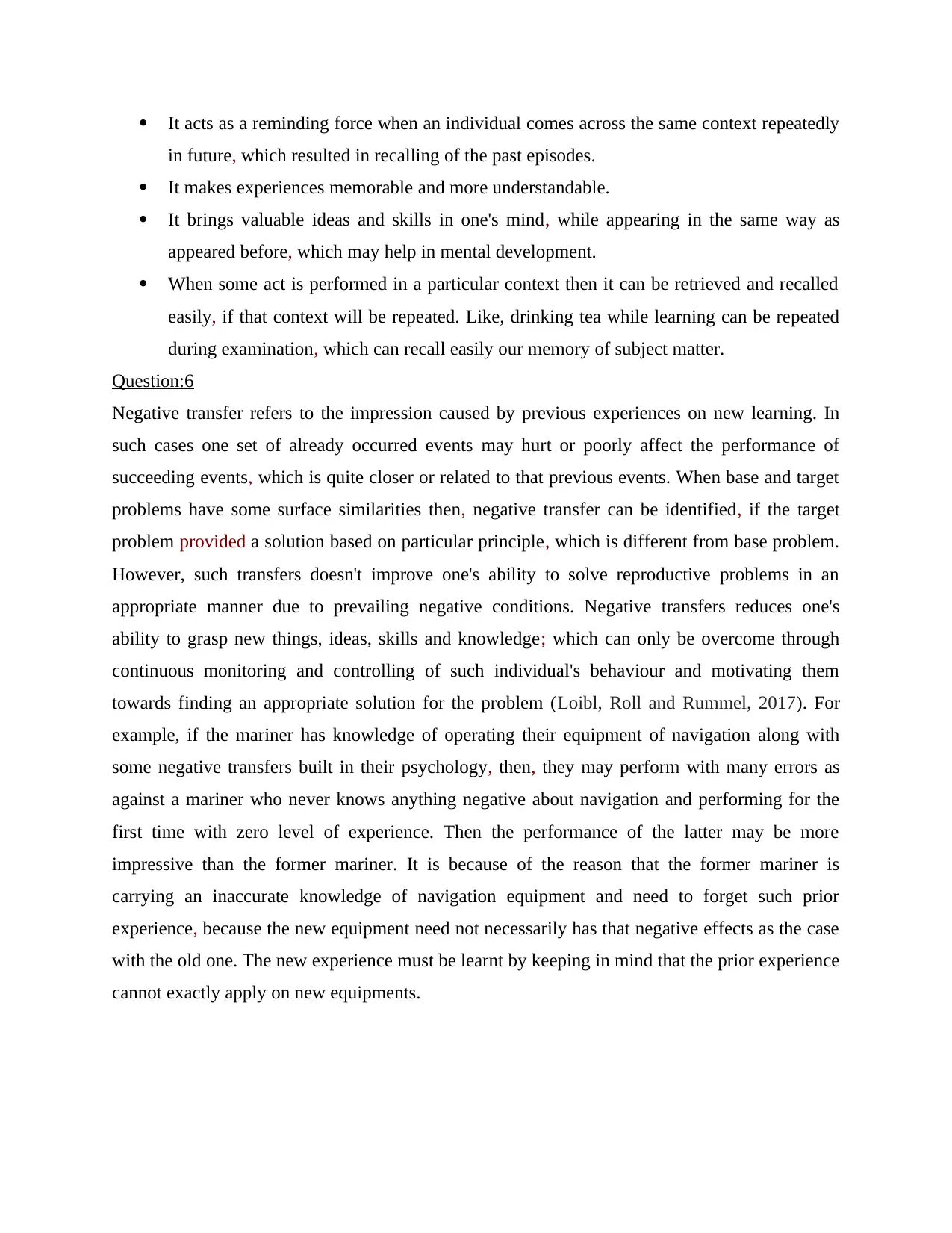
It acts as a reminding force when an individual comes across the same context repeatedly
in future, which resulted in recalling of the past episodes.
It makes experiences memorable and more understandable.
It brings valuable ideas and skills in one's mind, while appearing in the same way as
appeared before, which may help in mental development.
When some act is performed in a particular context then it can be retrieved and recalled
easily, if that context will be repeated. Like, drinking tea while learning can be repeated
during examination, which can recall easily our memory of subject matter.
Question:6
Negative transfer refers to the impression caused by previous experiences on new learning. In
such cases one set of already occurred events may hurt or poorly affect the performance of
succeeding events, which is quite closer or related to that previous events. When base and target
problems have some surface similarities then, negative transfer can be identified, if the target
problem provided a solution based on particular principle, which is different from base problem.
However, such transfers doesn't improve one's ability to solve reproductive problems in an
appropriate manner due to prevailing negative conditions. Negative transfers reduces one's
ability to grasp new things, ideas, skills and knowledge; which can only be overcome through
continuous monitoring and controlling of such individual's behaviour and motivating them
towards finding an appropriate solution for the problem (Loibl, Roll and Rummel, 2017). For
example, if the mariner has knowledge of operating their equipment of navigation along with
some negative transfers built in their psychology, then, they may perform with many errors as
against a mariner who never knows anything negative about navigation and performing for the
first time with zero level of experience. Then the performance of the latter may be more
impressive than the former mariner. It is because of the reason that the former mariner is
carrying an inaccurate knowledge of navigation equipment and need to forget such prior
experience, because the new equipment need not necessarily has that negative effects as the case
with the old one. The new experience must be learnt by keeping in mind that the prior experience
cannot exactly apply on new equipments.
in future, which resulted in recalling of the past episodes.
It makes experiences memorable and more understandable.
It brings valuable ideas and skills in one's mind, while appearing in the same way as
appeared before, which may help in mental development.
When some act is performed in a particular context then it can be retrieved and recalled
easily, if that context will be repeated. Like, drinking tea while learning can be repeated
during examination, which can recall easily our memory of subject matter.
Question:6
Negative transfer refers to the impression caused by previous experiences on new learning. In
such cases one set of already occurred events may hurt or poorly affect the performance of
succeeding events, which is quite closer or related to that previous events. When base and target
problems have some surface similarities then, negative transfer can be identified, if the target
problem provided a solution based on particular principle, which is different from base problem.
However, such transfers doesn't improve one's ability to solve reproductive problems in an
appropriate manner due to prevailing negative conditions. Negative transfers reduces one's
ability to grasp new things, ideas, skills and knowledge; which can only be overcome through
continuous monitoring and controlling of such individual's behaviour and motivating them
towards finding an appropriate solution for the problem (Loibl, Roll and Rummel, 2017). For
example, if the mariner has knowledge of operating their equipment of navigation along with
some negative transfers built in their psychology, then, they may perform with many errors as
against a mariner who never knows anything negative about navigation and performing for the
first time with zero level of experience. Then the performance of the latter may be more
impressive than the former mariner. It is because of the reason that the former mariner is
carrying an inaccurate knowledge of navigation equipment and need to forget such prior
experience, because the new equipment need not necessarily has that negative effects as the case
with the old one. The new experience must be learnt by keeping in mind that the prior experience
cannot exactly apply on new equipments.
⊘ This is a preview!⊘
Do you want full access?
Subscribe today to unlock all pages.

Trusted by 1+ million students worldwide
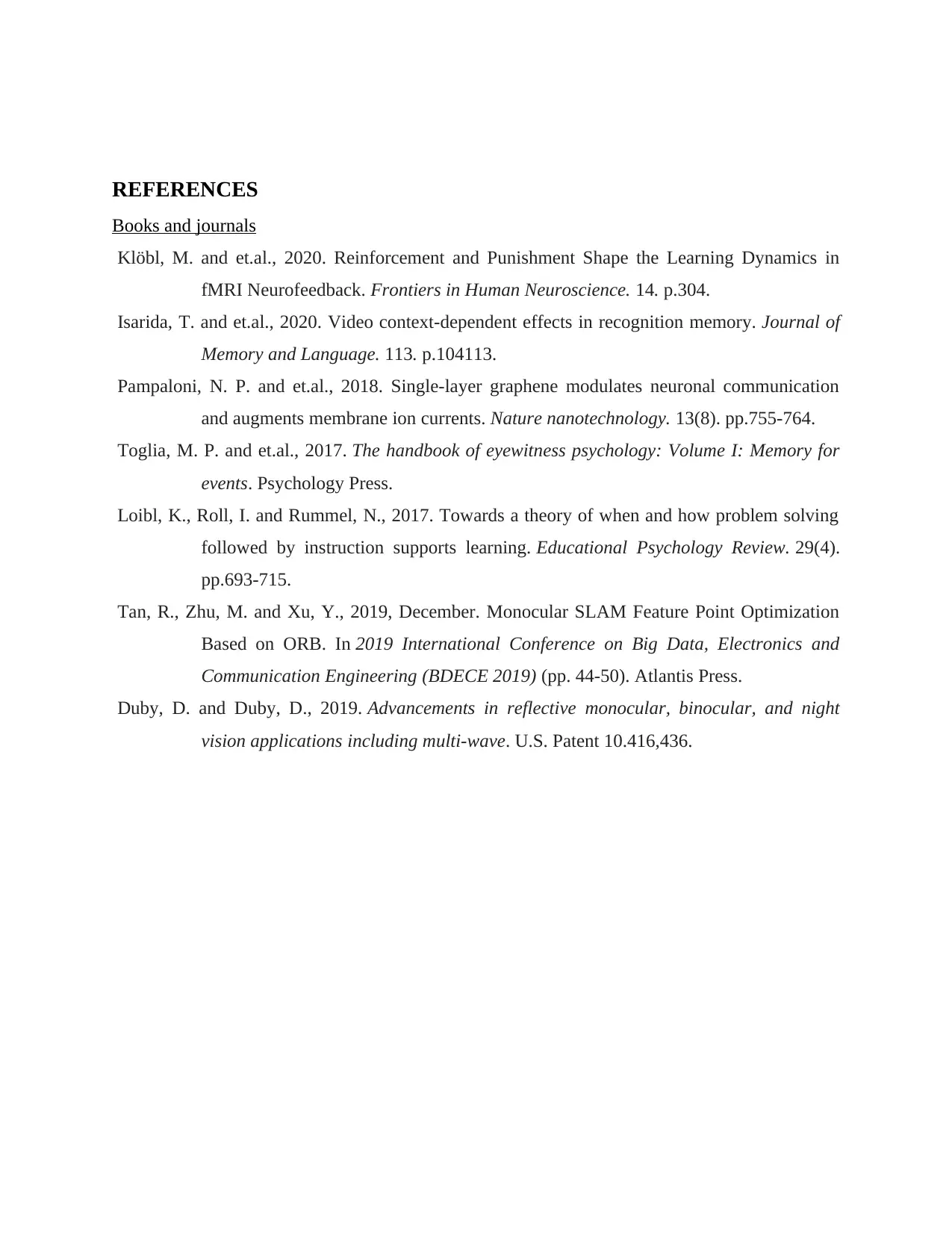
REFERENCES
Books and journals
Klöbl, M. and et.al., 2020. Reinforcement and Punishment Shape the Learning Dynamics in
fMRI Neurofeedback. Frontiers in Human Neuroscience. 14. p.304.
Isarida, T. and et.al., 2020. Video context-dependent effects in recognition memory. Journal of
Memory and Language. 113. p.104113.
Pampaloni, N. P. and et.al., 2018. Single-layer graphene modulates neuronal communication
and augments membrane ion currents. Nature nanotechnology. 13(8). pp.755-764.
Toglia, M. P. and et.al., 2017. The handbook of eyewitness psychology: Volume I: Memory for
events. Psychology Press.
Loibl, K., Roll, I. and Rummel, N., 2017. Towards a theory of when and how problem solving
followed by instruction supports learning. Educational Psychology Review. 29(4).
pp.693-715.
Tan, R., Zhu, M. and Xu, Y., 2019, December. Monocular SLAM Feature Point Optimization
Based on ORB. In 2019 International Conference on Big Data, Electronics and
Communication Engineering (BDECE 2019) (pp. 44-50). Atlantis Press.
Duby, D. and Duby, D., 2019. Advancements in reflective monocular, binocular, and night
vision applications including multi-wave. U.S. Patent 10.416,436.
Books and journals
Klöbl, M. and et.al., 2020. Reinforcement and Punishment Shape the Learning Dynamics in
fMRI Neurofeedback. Frontiers in Human Neuroscience. 14. p.304.
Isarida, T. and et.al., 2020. Video context-dependent effects in recognition memory. Journal of
Memory and Language. 113. p.104113.
Pampaloni, N. P. and et.al., 2018. Single-layer graphene modulates neuronal communication
and augments membrane ion currents. Nature nanotechnology. 13(8). pp.755-764.
Toglia, M. P. and et.al., 2017. The handbook of eyewitness psychology: Volume I: Memory for
events. Psychology Press.
Loibl, K., Roll, I. and Rummel, N., 2017. Towards a theory of when and how problem solving
followed by instruction supports learning. Educational Psychology Review. 29(4).
pp.693-715.
Tan, R., Zhu, M. and Xu, Y., 2019, December. Monocular SLAM Feature Point Optimization
Based on ORB. In 2019 International Conference on Big Data, Electronics and
Communication Engineering (BDECE 2019) (pp. 44-50). Atlantis Press.
Duby, D. and Duby, D., 2019. Advancements in reflective monocular, binocular, and night
vision applications including multi-wave. U.S. Patent 10.416,436.
Paraphrase This Document
Need a fresh take? Get an instant paraphrase of this document with our AI Paraphraser

1 out of 8
Your All-in-One AI-Powered Toolkit for Academic Success.
+13062052269
info@desklib.com
Available 24*7 on WhatsApp / Email
![[object Object]](/_next/static/media/star-bottom.7253800d.svg)
Unlock your academic potential
Copyright © 2020–2025 A2Z Services. All Rights Reserved. Developed and managed by ZUCOL.